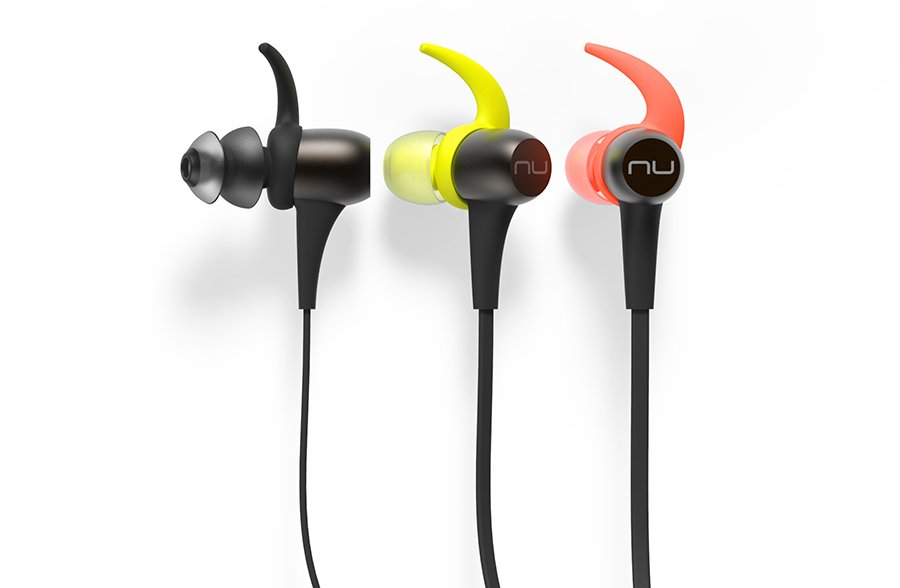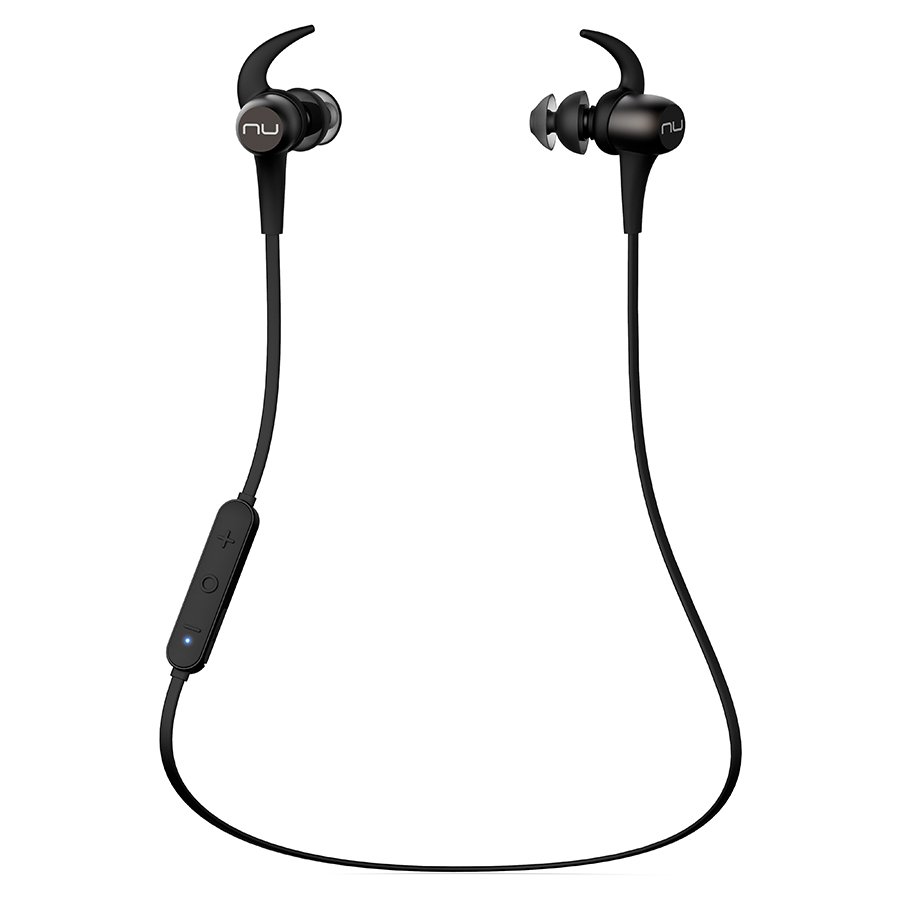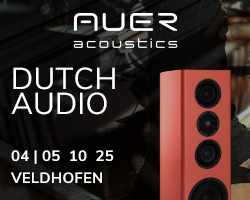Designed with the active music lover in mind the NuForce Sport3 In Ear Monitors cost £80. Janine Elliot gets gets physical with them.
Headphones and IEMs are quick moving and highly popular consumer items, especially sports headphones, and like I predicted would happen with the iPhone 7, WiFi IEMs are now the new must-haves. In times when wired earphones are beginning to be unplugged from the equation, wi-fi products are big news. They are imperative for the new ultra-thin phones such as iPhone 7 and Motorola Moto Z, that don’t need to make space for that large 3.5mm stereo socket. Optoma, the projector and audio brand who own Nu Force have brought out a wide variety of IEMs over the years and their previous wi-fi earphone the BE6i, which I reviewed earlier this year, was so good that I bought one. With its excellent bass, long life battery and light weight though bulky design, Nu Force have now brought out a sporty little number with a thinner waist which, annoyingly for me, is considerably cheaper. Crafted from metal and polycarbonate, the BE Sport3 is tough and lightweight. Like my BE6i it come armed with advanced Bluetooth® technology, offering both aptX® and AAC compatibility. This delivers distortion-free sound and the ability to connect to multiple sources. At £80, the Sport3 has a good supply of accessories, including a little bag to put the IEMs in, though this time it isn’t a solid feel bag but rather an equally impressive soft neoprene carrying pouch, with large clip, to protect the earphones and accessories from sweat and water. As in the Optoma BE6i, this new model features handy magnets on the backs of the buds for clipping them together when not in use, acting as a designer necklace for no extra cost. There are also some significant differences between this and the older model; some visual and others technical. For example the shape is angled and smaller, again partly made from aluminium. This I actually preferred as it meant it was able to fit in and around the ear more easily. Also there are no Comply tips supplied this time, rather a collection of more traditional though very colourful rubber ear tips, and a clever custom double ear-tip which, once in your ear canal, is cleverly held in place. I did try these on my BE6i, but this different design means that the ear is not so well insulated from the outside world. Similarly on the Sport3, whilst the treble was excellent the lack of ‘ear-pressure’ means the bass is still somewhat light. The double tips supplied for each of the two versions of Sport3 are in a different colour; on the “gun metal grey” IEMs the double tip was black, with matching silicone ear-wings, and on the “Rose Gold” IEM (gold plus white cable/remote) it was white. Similarly, both units came with a selection of small, medium and large rubber tips to match the IEMs. The black unit comes with three pink and yellow rubber ear-tips and the white version has blue and purple ones. All provide a good isolation, improving that bass end to acceptable levels, though the matching supplied ear-wings that I loved so much on the BE6i, are less clever in this new model, being a pointed solid construction (rather than corrugated as in the BE6i) which isn’t so secure behind the ear anti helix unless the pointed end is tucked in. These Spock ear wings are actually quite long and it took me a while to get them affixed in my tiny ear without the whole IEMs falling out. Once I mastered this they were actually even more secure than my own BE6i. The choice between his type of fixture and those that fit behind your ear or relying on cables trailing behind your ears (such as Nu Force’s own Primo8 and HEM series) mean there are lots of choices for your ears. Once the ear-wing was affixed to the nozzle this IEM looked much less clumsy than on the BE6i which some might find too big. However, I must stress that whilst I am used to the miniature Flare R2 IEMs, which are hidden within my ear, I didn’t actually find size a problem with the much larger BE6i, and certainly not the Sport3. However, the added length between the ear-wing and tips is greater on the Sport3 than on the BE6i, requiring some careful wearing; the distance from wings to end of the large ear tips is 14mm as opposed to 10mm on the BE6i using the large Comply tip. You get my point. I pride myself on having small ears, even as I get older, so at first I did find these hard to wear, but in HifiPig style I persevered until I got them to work really well. For most of the tests I chose to remove the ear-wings, and using the larger pink rubber tips which provided better isolation than the double tips and consequently gave a better bass end. With the double tip, this was even more secure though its lack of thickness of rubber gave for a brighter sound as a result of less isolation and therefore less bass.
The BE Sport3 is even better than the BE6i in terms of excellent battery life, giving as it does up to 10 hours between charging, as opposed to 8 hours on the older machine. This is a really good set of results, when so many still don’t offer more than 5 or 6 hours. As in the BE6i this model is apX and AAC compatibility, and it being IP55 rated makes them rain, dust and sweat resistant, though you still won’t be able to go swimming with them. The remote/microphone unit is slightly shorter than on the BE6i, and again the microphone is good with a sensitivity of -42dB. Rather than the usual musical tones to inform you of switch on and when it links with your phone, this machine more helpfully talks to you in a rather sombre female American voice; “Power off”, “Power on” and “Primary device connected”. The 6mm dynamic driver is much smaller than the 10mm driver on the BE6i. This affects the bass output, though the Sport3 is not lacking by any means. This IEM is not a cut-back version of the BE6i; this is a well thought-out design for the pseudo-athlete that is well priced. It doesn’t look quite as robust or high-end as the BE6i or the wired IEMs in the Nu Force range, but in terms of battery life and sound quality beats most of the competition. The thin neck on the bud allows it to go further into the ear canal to help improve that bass end, though I did find it was slightly prominent in the upper bass and detail of sound is less well defined than some wired drivers at this price point. Upper mid and high was very acceptable allowing Dire Straits ‘Love over Gold’ to be very open and spacious between the ears showing good control. Muse ‘The second Order’ and the track “Survival” gave a very timely and precise piano and vocal accompaniment beat for the smooth main vocal line. Classical music was equally detailed, though not quite as accurate and as musical as the BE6i, but still very able. Sir Charles Groves and the Bournemouth Symphony orchestra playing Arnold English Dances is a great performance, only hindered by the studio manager’s nightmare of vibrations from microphone stands when the musicians and conductor get over-excited. This IEM picked it up well. At the other end of the spectrum the regular loud cymbal crashes in this set of movements gave me a real opportunity to test that upper frequency detail and neutrality. My fears of a slightly less controlled and slightly raised mid-top end were heard, though not unexpected for such a well-priced unit. To test this theory further playing Patricia Barber ‘Café Blue’ I was aware that some of that top frequency cymbals were slightly less controlled and a little bit more ‘brittle’ than the silky smooth rendition on the BE6i.
Conclusion
The BE Sport3 is a very well thought out design, aimed at the active sports’ person with its vibrant colours and sporty looks. This model might have cut back on the shape of the buds and even the cable has a thinner waist than on the BE6i, but this is not an anorexic BE6i. Whether or not you intend to take part in the Olympics this is a bargain if you like music on the move without getting tangled up in the wires. At £80 this is a very well spec’d model that should make you and your wallet very happy.
Build Quality: Good looking and with lots of extras in the box
Sound Quality: Great sound at this price
Value For Money: Well spec’d and good value
Pros
Value for money
apX and AAC compatibility
Solid build
Excellent battery Life
Lots of accessories
Cons
Not quite as silky top end as on the BE6i
Some might find them hard to use with the ear-wings
Price: £80
Specification
Driver type; Dynamic Driver size 6mm
Impedance; 16 Ohms
Battery life; Up to around 10 hours
Battery type; Lithium-ion battery, cylindrical type, typical 3.7V/75mAhx2 pcs
Microphone sensitivity; -42dB
Frequency response; 20Hz – 20kHz
Sensitivity; 102dB +/-3dB at 1KHz
Power consumption; 18mA at A2DP mode,
speaker output; 75dB SPL
Range; Up to 10m (33ft)






































































































































































































You must be logged in to leave a reply.